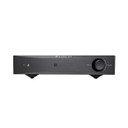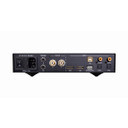Affordable High-End DAC for Demanding Audiophiles
With eight digital inputs, an RCA stereo output, and decoding capability of PCM 384K, DSD256, the NuPrime DAC-8 is an affordable high-end DAC with preamp functionality designed for demanding audiophiles. Full microprocessor control with memory retention makes operation especially convenient. There is also an extension port for an optional Bluetooth receiver and WiFi audio streamer.
The DAC-8 uses NuPrime's SRC IC chip (co-developed with the IC vendor) providing DSP processing where input signals are up-sampled to megahertz before down-converted to the targeted sampling rate with ultra-low jitter and distortion. The DAC-8 supports DSD native playback by ASIO2.1 and DoP and uses asynchronous transfer mode for vanishingly low jitter.
Preamp Functionality
With multiple digital inputs and RCA analog outputs along with adjustable volume control, the DAC-8 offers preamp functionality. This lets you connect the DAC-8 directly to a power amplifier if you wish, eliminating extra components in your system. Features included from high-end preamps include a premium volume control providing volume adjustment in 99 precise 0.5dB increments. Individually adjustable volume on each input is available for accurate level matching of sources.
Using Bluetooth and WiFi Audio Receivers and Dongles
NuPrime's DAC-8 has a USB Type-A port to carry S/PDIF data and 5V power for connecting an external wireless audio receiver (optional, sold separately) using just one standard USB cable. The NuPrime Omnia WR-1, BTR-HD, Stream Mini, and Stream Mini DAC wireless receivers have a micro USB port that is compatible this specification. This allow a standard off-the-shelf USB-A to micro USB cable to be used for power for the receiver as well as wireless audio data transfer in S/PDIF format.
From Hi-Res to Extreme Resolution
The NuPrime DAC-8 is designed to faithfully reproduce all types of music irrespective of the digital file format used. High-volume storage has become cheap enough for the proliferation of hi-res music beyond CD quality (16-bit/44.1kHz). Storing 24-bit/96 kHz or 192 kHz music with PCM encoding in uncompressed format (typically WAV) or lossless compression format (such as FLAC, M4A, WMA) has become standard practice for audio enthusiasts.
Music is typically recorded in 24 or 32-bit PCM or DSD format at the recording studio. It is then converted to lower resolution format for mass-market distribution.
Pulse-code Modulation (PCM)
Pulse-code modulation (PCM) is a method used to digitally represent sampled analog signals. It is the standard form of digital audio in computers, compact discs, and other digital audio applications. In a PCM stream, the amplitude of the analog signal is sampled regularly at uniform intervals and each sample is quantized to the nearest value within a range of digital steps.
A PCM stream has two basic properties that determine the stream's fidelity to the original analog signal. These are the sampling rate, which is the number of times per second that samples are taken, and the bit depth, which determines the number of possible digital values that can be used to represent each sample. DXD is simply PCM 24-bit/352.8 kHz.
Direct-Stream Digital (DSD)
Direct-Stream Digital (DSD) is the trademark name used by Sony and Philips for their system of digitally recreating audible signals for the Super Audio CD (SACD). DSD uses pulse-density modulation encoding – a technology to store audio signals on digital storage media that are used for the SACD. The signal is stored as delta-sigma modulated digital audio, a sequence of single-bit values at a sampling rate of 2.8224 MHz (64 times the CD Audio sampling rate of 44.1 kHz, but only at 1⁄32768 of its 16-bit resolution).
The same music in DSD64 (2.8 MHz sampling rate) format takes up about 20% more storage space than 24-bit/96kHz format.





























